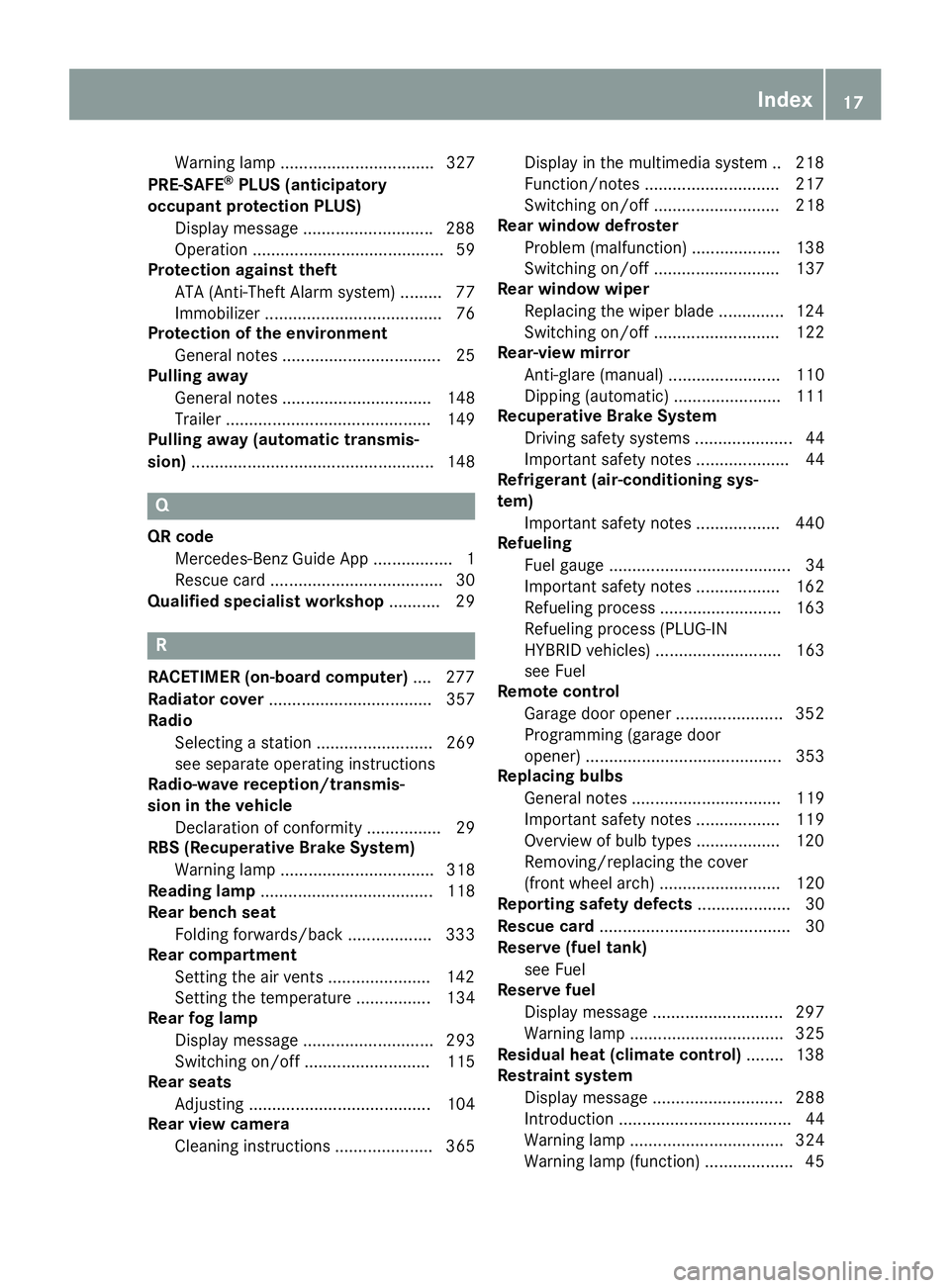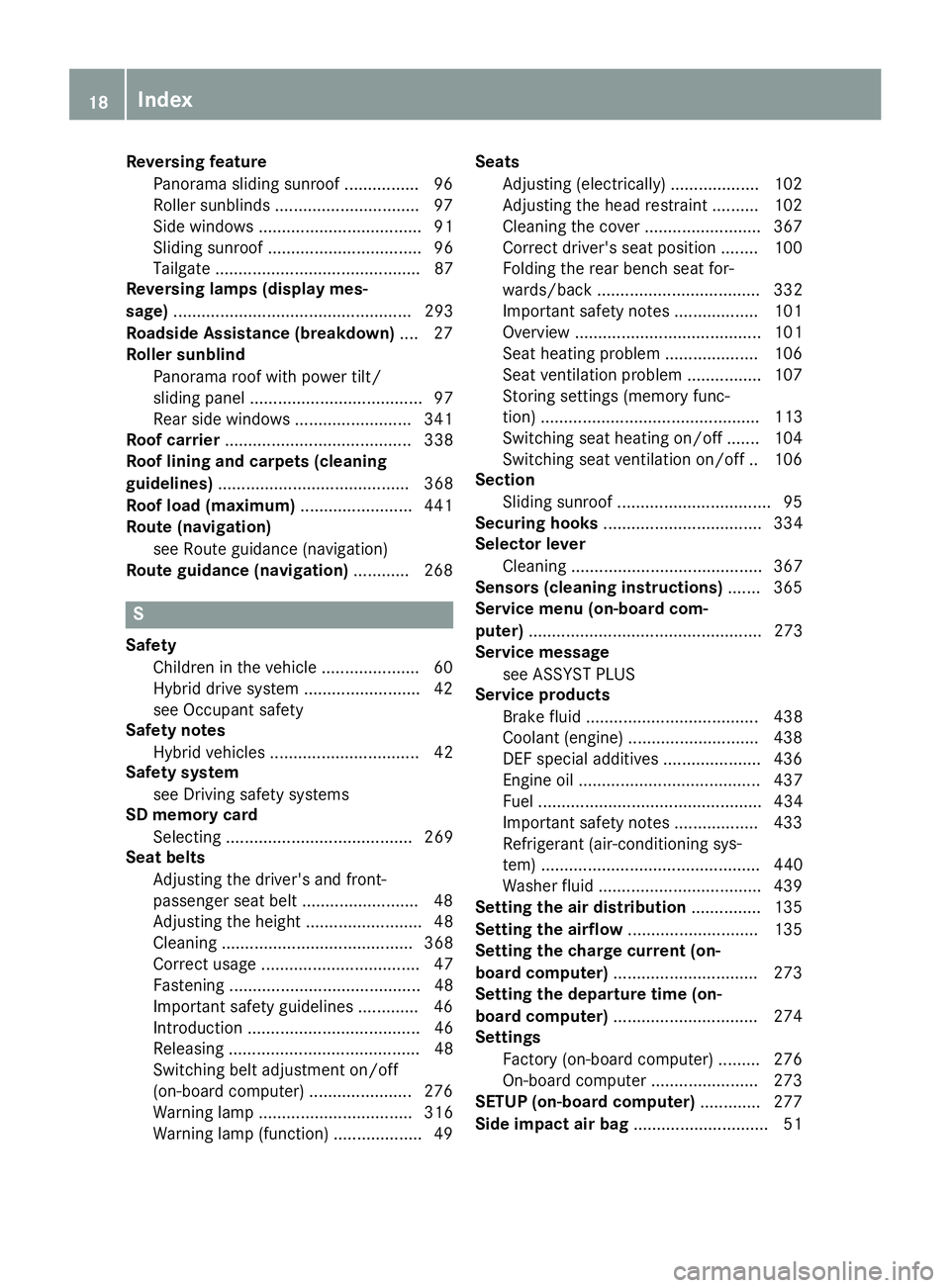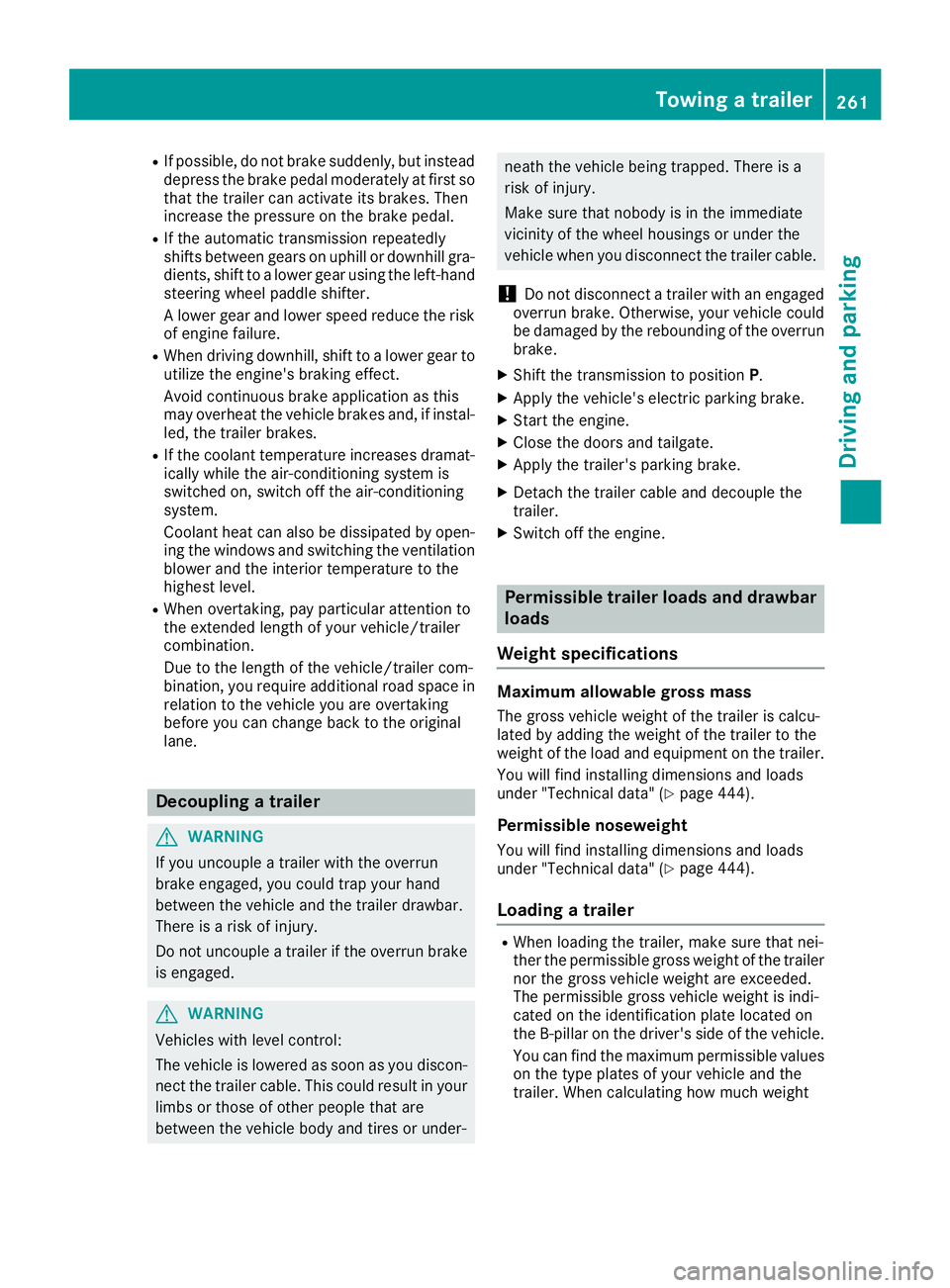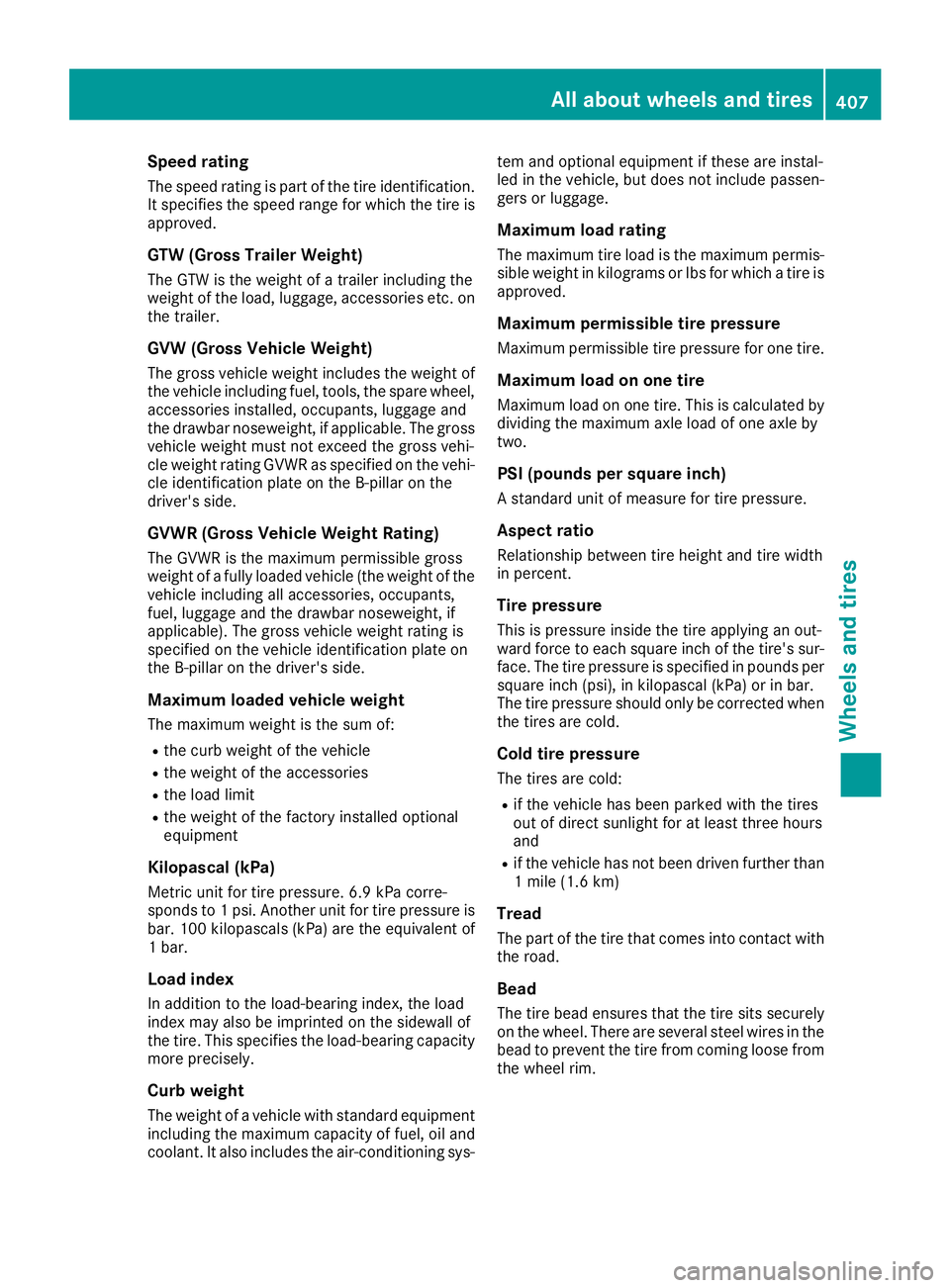2016 MERCEDES-BENZ GLE air conditioning
[x] Cancel search: air conditioningPage 5 of 450

1, 2, 3 ... 4ETS (Electronic Traction System)
see ETS/4ETS (Electronic Trac-
tion System)
4MATIC (permanent four-wheel
drive) .................................................. 235
12 V socket
see Sockets
115 V socket ...................................... 343
360° camera
Cleaning ........................................ .3 66
Display in the multimedia system .. 222
Function/notes ............................ .2 21
A ABS (Anti-lock Braking System)
Display message ............................ 281
Function/notes ................................ 66
Important safety notes .................... 66
Warning lamp ................................. 319
Accident
Automatic measures after an acci-
dent ................................................. 59
Activating/deactivating cooling
with air dehumidification ................. 132
Active Blind Spot Assist
Activating/deactivating (on-
board computer) ............................ 272
Display message ............................ 305
Function/information .................... 230
Trailer towing ................................. 233
Active Curve System
Display message ............................ 303
Function/notes ............................. 207
Active Driving Assistance package .. 230
Active Lane Keeping Assist
Activating/deactivating (on-
board computer) ............................ 272
Display message ............................ 305
Function/information .................... 233
Trailer towing ................................. 235
Active Parking Assist
Display message ............................ 306
Exiting a parking space .................. 216
Function/notes ............................. 213
Important safety notes .................. 213 Parking .......................................... 215
ADAPTIVE BRAKE ................................. 74
Adaptive Brake Assist
Function/notes ................................ 70
Adaptive Damping System
Function/notes ............................. 209
Adaptive damping system
see ADS (Adaptive Damping System)
Adaptive Highbeam Assist
Display message ............................ 295
Function/notes ............................. 117
Switching on/off ........................... 118
Additives (engine oil) ........................ 438
ADS (Adaptive Damping System)
Function/notes ............................. 206
Air bags
Deployment ..................................... 56
Display message ............................ 290
Front air bag (driver, front
passenger) ....................................... 50
Important safety notes .................... 49
Introduction ..................................... 49
Knee bag .......................................... 51
Occupant Classification System
(OCS) ............................................... 52
P ASSENG
ER AIR BAG indicator
lamps ............................................... 45
Side impact air bag .......................... 51
Window curtain air bag .................... 51
Air filter (display message) .............. 298
AIR FLOW ........................................... 134
Air vents
Glove box ....................................... 142
Important safety notes .................. 141
Rear ............................................... 142
Setting ........................................... 141
Setting the center air vents ........... 142
Setting the side air vents ............... 142
Air-conditioning system
see Climate control
AIRMATIC package
ADS (Adaptive Damping System) ... 206
Function/notes ............................. 205
Alarm
ATA (Anti-Theft Alarm system) ......... 77
Switching off (ATA) .......................... 77
Switching the function on/off
(ATA) ................................................ 77 Index 3
Page 19 of 450

Warning lamp ................................. 327
PRE-SAFE ®
PLUS (anticipatory
occupant protection PLUS)
Display message ........................... .2 88
Operation ......................................... 59
Protection against theft
ATA (Anti-Theft Alarm system) ......... 77
Immobilizer ...................................... 76
Protection of the environment
General notes .................................. 25
Pulling away
General notes ................................ 148
Trailer ............................................ 149
Pulling away (automatic transmis-
sion) .................................................... 148
Q QR code
Mercedes-Benz Guide App ................. 1
Rescue card ..................................... 30
Qualified specialist workshop ........... 29
R
RACETIMER (on-board computer) .... 277
Radiator cover ................................... 357
Radio
Selecting a station ......................... 269
see separate operating instructions
Radio-wave reception/transmis-
sion in the vehicle
Declaration of conformity ................ 29
RBS (Recuperative Brake System)
Warning lamp ................................. 318
Reading lamp ..................................... 118
Rear bench seat
Folding forwards/back .................. 333
Rear compartment
Setting the air vents ..................... .1 42
Setting the temperature ................ 134
Rear fog lamp
Display message ............................ 293
Switching on/off ........................... 115
Rear seats
Adjusting ....................................... 104
Rear view camera
Cleaning instructions ..................... 365 Display in the multimedia system .. 218
Function/notes ............................ .2 17
Switching on/off ........................... 218
Rear window defroster
Problem (malfunction) ................... 138
Switching on/off ........................... 137
Rear window wiper
Replacing the wiper blade .............. 124
Switching on/off ........................... 122
Rear-view mirror
Anti-glare (manual) ........................ 110
Dipping (automatic) ....................... 111
Recuperative Brake System
Driving safety systems ..................... 44
Important safety notes .................... 44
Refrigerant (air-conditioning sys-
tem)
Important safety notes .................. 440
Refueling
Fuel gauge ....................................... 34
Important safety notes .................. 162
Refueling process .......................... 163
Refueling process (PLUG-IN
HYBRID vehicles) ........................... 163
see Fuel
Remote control
Garage door opener ....................... 352
Programming (garage door
opener) .......................................... 353
Replacing bulbs
General notes ................................ 119
Important safety notes .................. 119
Overview of bulb types .................. 120
Re moving/rep lacing the cover
( front wheel arch) .......................... 120
Reporting safety defects .................... 30
Rescue card ......................................... 30
Reserve (fuel tank)
see Fuel
Reserve fuel
Display message ............................ 297
Warning lamp ................................. 325
Residual heat (climate control) ........ 138
Restraint system
Display message ............................ 288
Introduction ..................................... 44
Warning lamp ................................. 324
Warning lamp (function) ................... 45 Index 17
Page 20 of 450

Reversing feature
Panorama sliding sunroof ................ 96
Roller sunblinds ............................... 97
Side windows ................................... 91
Sliding sunroof ................................. 96
Tailgate ............................................ 87
Reversing lamps (display mes-
sage) ................................................... 293
Roadside Assistance (breakdown) .... 27
Roller sunblind
Panorama roof with power tilt/
sliding panel ..................................... 97
Rear side windows ......................... 341
Roof carrier ........................................ 338
Roof lining and carpets (cleaning
guidelines) ......................................... 368
Roof load (maximum) ........................ 441
Route (navigation)
see Route guidance (navigation)
Route guidance (navigation) ............ 268
SSafety
Children in the vehicle ..................... 60
Hybrid drive system ......................... 42
see Occupant safety
Safety notes
Hybrid vehicles ................................ 42
Safety system
see Driving safety systems
SD memory card
Selecting ........................................ 269
Seat belts
Adjusting the driver's and front-
passenger seat belt ......................... 48
Adjusting the height ......................... 48
Cleaning ......................................... 368
Correct usage .................................. 47
Fastening ......................................... 48
Important safety guidelines ............. 46
Introduction ..................................... 46
Releasing ......................................... 48
Switching belt adjustment on/off
(on-board computer) ...................... 276
Warning lamp ................................. 316
Warning lamp (function) ................... 49 Seats
Adjusting (electrically) ................... 102
Adjusting the head restraint .......... 102
Cleaning the cover ......................... 367
Correct driver's seat position ........ 100
Folding the rear bench seat for-
wards/back ................................... 332
Important safety notes .................. 101
Overview ........................................ 101
Seat heating problem .................... 106
Seat ventilation problem ................ 107
Storing settings (memory func-
tion) ............................................... 113
Switching seat heating on/off ....... 104
Switching seat ventilation on/off .. 106
Section
Sliding sunroof ................................. 95
Securing hooks .................................. 334
Selector lever
Cleaning ......................................... 367
Sensors (cleaning instructions) ....... 365
Service menu (on-board com-
puter) .................................................. 273
Service message
see ASSYST PLUS
Service products
Brake fluid ..................................... 438
Coolant (engine) ............................ 438
DEF special additives ..................... 436
Engine oil ....................................... 437
Fuel ................................................ 434
Important safety notes .................. 433
Refrigerant (air-conditioning sy s-
tem) ............................................... 440
Washer fluid ................................... 439
Setting the air distribution ............... 135
Setting the airflow ............................ 135
Setting the charge current (on-
board computer) ............................... 273
Setting the departure time (on-
board computer) ............................... 274
Settings
Factory (on-board computer) ......... 276
On-board computer ....................... 273
SETUP (on-board computer) ............. 277
Side impact air bag ............................. 5118
Index
Page 263 of 450

R
If possible, do not brake suddenly, but instead
depress the brake pedal moderately at first so
that the trailer can activate its brakes. Then
increase the pressure on the brake pedal. R
If the automatic transmission repeatedly
shifts between gears on uphill or downhill gra-
dients, shift to a lower gear using the left-hand
steering wheel paddle shifter.
A lower gear and lower speed reduce the risk
of engine failure. R
When driving downhill, shift to a lower gear to
utilize the engine's braking effect.
Avoid continuous brake application as this
may overheat the vehicle brakes and, if instal-
led, the trailer brakes. R
If the coolant temperature increases dramat-
ically while the air-conditioning system is
switched on, switch off the air-conditioning
system.
Coolant heat can also be dissipated by open-
ing the windows and switching the ventilation
blower and the interior temperature to the
highest level. R
When overtaking, pay particular attention to
the extended length of your vehicle/trailer
combination.
Due to the length of the vehicle/trailer com-
bination, you require additional road space in
relation to the vehicle you are overtaking
before you can change back to the original
lane.
Decoupling a trailer
G WARNING
If you uncouple a trailer with the overrun
brake engaged, you could trap your hand
between the vehicle and the trailer drawbar.
There is a risk of injury.
Do not uncouple a trailer if the overrun brake
is engaged.
G WARNING
Vehicles with level control:
The vehicle is lowered as soon as you discon-
nect the trailer cable. This could result in your
limbs or those of other people that are
between the vehicle body and tires or under- neath the vehicle being trapped. There is a
risk of injury.
Make sure that nobody is in the immediate
vicinity of the wheel housings or under the
vehicle when you disconnect the trailer cable.
! Do not disconnect a trailer with an engaged
overrun brake. Otherwise, your vehicle could
be damaged by the rebounding of the overrun
brake. X
Shift the transmission to position P .X
Apply the vehicle's electric parking brake. X
Start the engine. X
Close the doors and tailgate. X
Apply the trailer's parking brake. X
Detach the trailer cable and decouple the
trailer. X
Switch off the engine.
Permissible trailer loads and drawbar
loads
Weight specifications
Maximum allowable gross mass The gross vehicle weight of the trailer is calcu-
lated by adding the weight of the trailer to the
weight of the load and equipment on the trailer.
You will find installing dimensions and loads
under "Technical data" ( Y
page 444).
Permissible noseweight
You will find installing dimensions and loads
under "Technical data" ( Y
page 444).
Loading a trailer R
When loading the trailer, make sure that nei-
ther the permissible gross weight of the trailer
nor the gross vehicle weight are exceeded.
The permissible gross vehicle weight is indi-
cated on the identification plate located on
the B-pillar on the driver's side of the vehicle.
You can find the maximum permissible values
on the type plates of your vehicle and the
trailer. When calculating how much weightTowing a trailer 261
Driving and parking Z
Page 409 of 450

Speed rating The speed rating is part of the tire identification.
It specifies the speed range for which the tire is
approved.
GTW (Gross Trailer Weight) The GTW is the weight of a trailer including the
weight of the load, luggage, accessories etc. on
the trailer.
GVW (Gross Vehicle Weight) The gross vehicle weight includes the weight of
the vehicle including fuel, tools, the spare wheel,
accessories installed, occupants, luggage and
the drawbar noseweight, if applicable. The gross
vehicle weight must not exceed the gross vehi-
cle weight rating GVWR as specified on the vehi-
cle identification plate on the B-pillar on the
driver's side.
GVWR (Gross Vehicle Weight Rating) The GVWR is the maximum permissible gross
weight of a fully loaded vehicle (the weight of the
vehicle including all accessories, occupants,
fuel, luggage and the drawbar noseweight, if
applicable). The gross vehicle weight rating is
specified on the vehicle identification plate on
the B-pillar on the driver's side.
Maximum loaded vehicle weight The maximum weight is the sum of: R
the curb weight of the vehicle R
the weight of the accessories R
the load limit R
the weight of the factory installed optional
equipment
Kilopascal (kPa)
Metric unit for tire pressure. 6.9 kPa corre-
sponds to 1 psi. Another unit for tire pressure is
bar. 100 kilopascals (kPa) are the equivalent of
1 bar.
Load index
In addition to the load-bearing index, the load
index may also be imprinted on the sidewall of
the tire. This specifies the load-bearing capacity
more precisely.
Curb weight
The weight of a vehicle with standard equipment
including the maximum capacity of fuel, oil and
coolant. It also includes the air-conditioning sys- tem and optional equipment if these are instal-
led in the vehicle, but does not include passen-
gers or luggage.
Maximum load rating The maximum tire load is the maximum permis-
sible weight in kilograms or lbs for which a tire is
approved.
Maximum permissible tire pressure Maximum permissible tire pressure for one tire.
Maximum load on one tire Maximum load on one tire. This is calculated by
dividing the maximum axle load of one axle by
two.
PSI (pounds per square inch) A standard unit of measure for tire pressure.
Aspect ratio Relationship between tire height and tire width
in percent.
Tire pressure This is pressure inside the tire applying an out-
ward force to each square inch of the tire's sur-
face. The tire pressure is specified in pounds per
square inch (psi), in kilopascal (kPa) or in bar.
The tire pressure should only be corrected when
the tires are cold.
Cold tire pressure The tires are cold: R
if the vehicle has been parked with the tires
out of direct sunlight for at least three hours
and R
if the vehicle has not been driven further than
1 mile (1.6 km)
Tread
The part of the tire that comes into contact with
the road.
Bead
The tire bead ensures that the tire sits securely
on the wheel. There are several steel wires in the
bead to prevent the tire from coming loose from
the wheel rim.All about wheels and tires 407
Wheels and tires Z